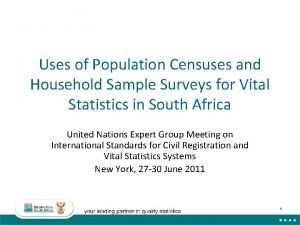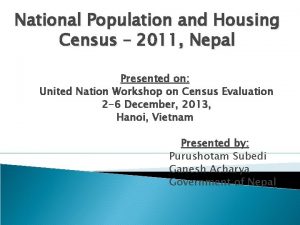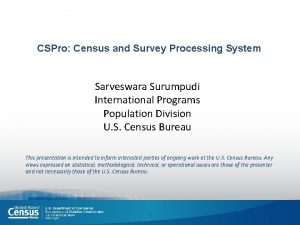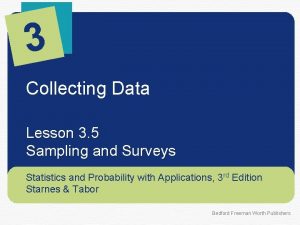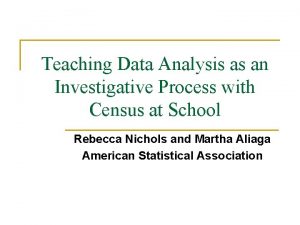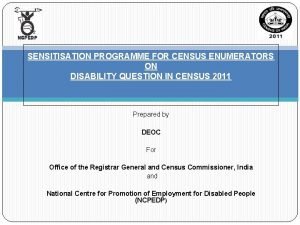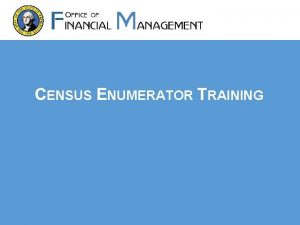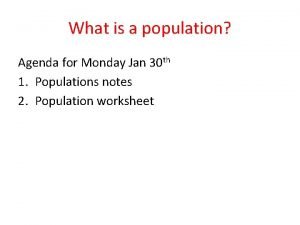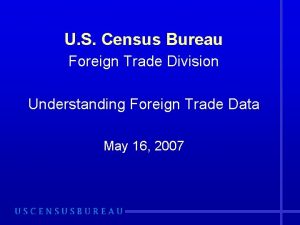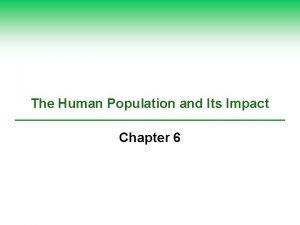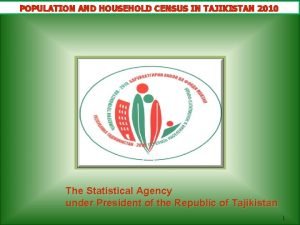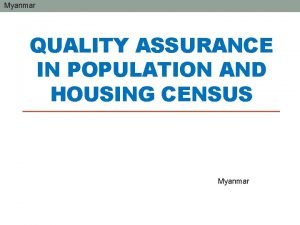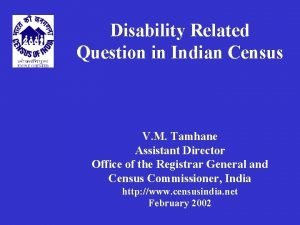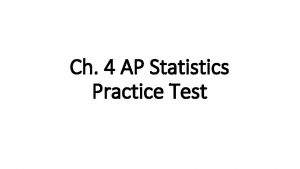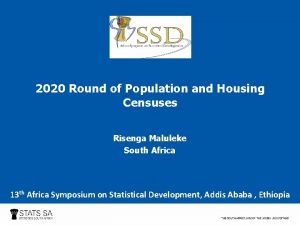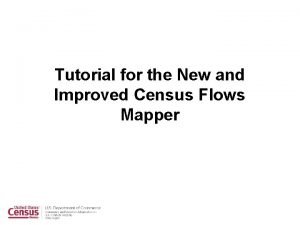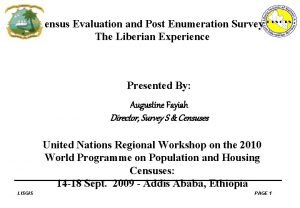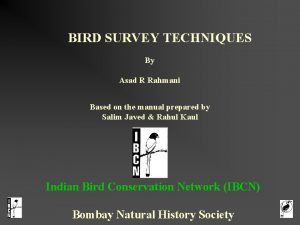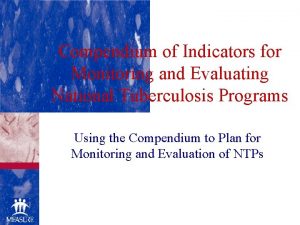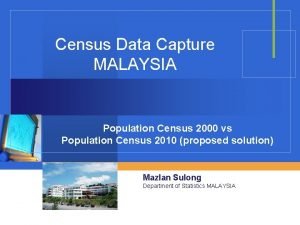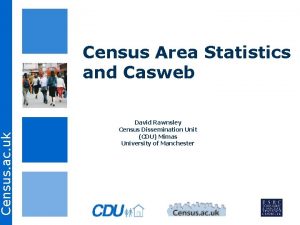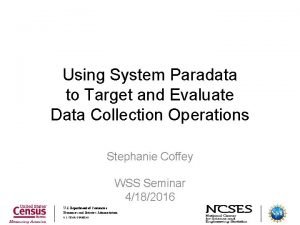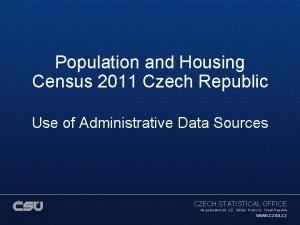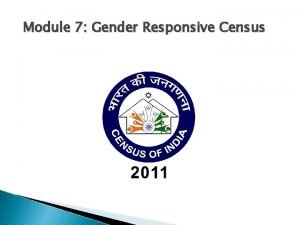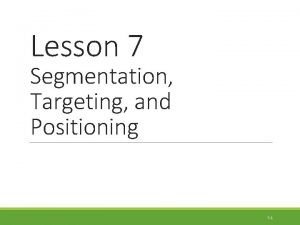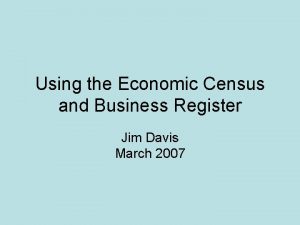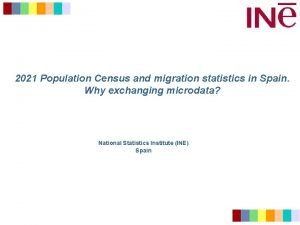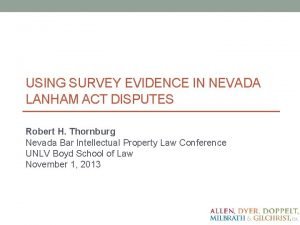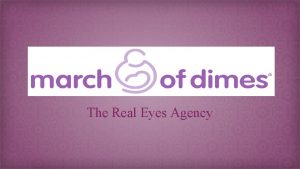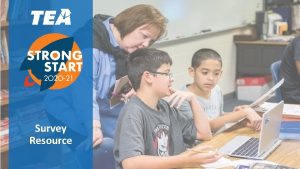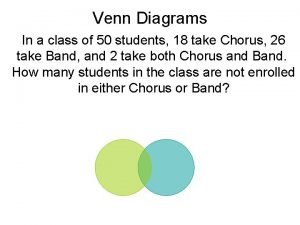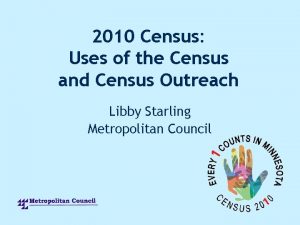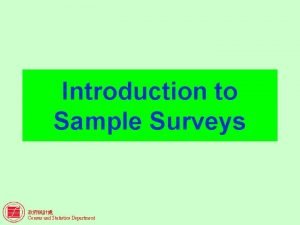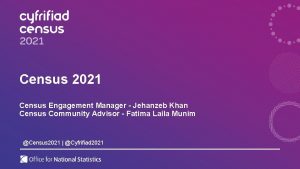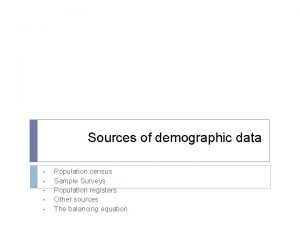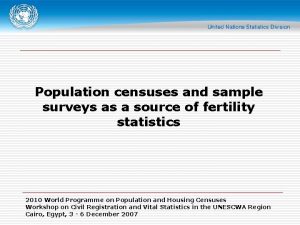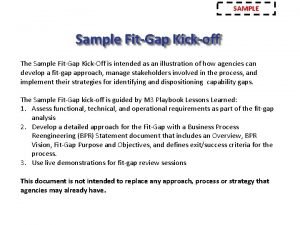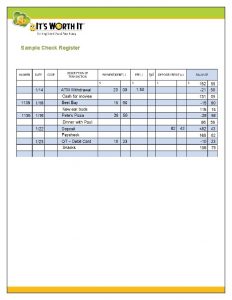Census and Sample Surveys as a Source of



















![2. Birth Histories - Estimation o At each given age: P [dying] = # 2. Birth Histories - Estimation o At each given age: P [dying] = #](https://slidetodoc.com/presentation_image_h2/0cc72bc24baae8d96c7ae0bfc5501fd7/image-20.jpg)

































- Slides: 53

Census and Sample Surveys as a Source of Mortality Data Session 10 b (for Statisticians) 2010 World Programme on Population and Housing Censuses Workshop on Civil Registration and Vital Statistics in the UNESCWA Region Cairo, Egypt, 3 - 6 December 2007

Outline o Introduction o Five methods of estimating mortality statistics 1. 2. 3. 4. 5. Survival of children ever born Birth histories Recent household deaths Survival of parents Survival of siblings 2010 World Programme on Population and Housing Censuses Workshop on Civil Registration and Vital Statistics in the UNESCWA Region Cairo, Egypt, 3 - 6 December 2007

Introduction o A group of questions can be used to obtain mortality data in a census or a survey o Two distinctions: a) Level and trend of mortality vs. age pattern of mortality b) Deaths of younger persons vs. deaths of adults o All approaches are to supplement death registration data, not to replace it. o They may be used to provide information for subgroups not identifiable from registration data. 2010 World Programme on Population and Housing Censuses Workshop on Civil Registration and Vital Statistics in the UNESCWA Region Cairo, Egypt, 3 - 6 December 2007

1. Survival of Children ever Born - Questions o Have been used for the past 50 years to collect data on infant and child mortality o Their purpose is to ascertain, for every woman asked: a) the total number of female children she has borne in her lifetime. b) the total number of male children she has borne in her lifetime. c) the number of female children who are surviving d) the number of male children who are surviving o Resulting data is used to estimate mortality levels and trends for females and males. 2010 World Programme on Population and Housing Censuses Workshop on Civil Registration and Vital Statistics in the UNESCWA Region Cairo, Egypt, 3 - 6 December 2007

1. Survival of Children ever Born - Questions o Ever born – Surviving = Children deceased o Children deceased / Ever born = Proportion deceased o Life table measures of infant, child and young adult mortality may be derived from the proportion of deceased. 2010 World Programme on Population and Housing Censuses Workshop on Civil Registration and Vital Statistics in the UNESCWA Region Cairo, Egypt, 3 - 6 December 2007

1. Survival of Children ever Born - Tabulation o Standard tabulations of children surviving and children ever born are identical o However, use of separate tables may introduce bias into calculated proportions of deceased children when estimating infant and child mortality. n n A woman who reports children ever born but not children surviving will be treated as though all her children have died. A woman who reports children surviving but not children ever born will be counted as having a negative number of deceased children 2010 World Programme on Population and Housing Censuses Workshop on Civil Registration and Vital Statistics in the UNESCWA Region Cairo, Egypt, 3 - 6 December 2007

1. Survival of Children ever Born - Tabulation o This bias can be avoided by producing a special composite tabulation Age of mother Women reporting CEB and CS CEB * CS ** Women reporting CEB but not CS Women reporting CS but not CEB Women not reporting CEB or CS 15 -19 20 -24. . 80 -84 85+ 2010 World Programme on Population and Housing Censuses Workshop on Civil Registration and Vital Statistics in the UNESCWA Region Cairo, Egypt, 3 - 6 December 2007

1. Survival of Children ever Born - Tabulation o The proportion of deceased children among children ever born must be made only for women with responses available for columns CEB and CS o The proportions of deceased children are computed from the first three columns. o The three columns at right are only for diagnostics 2010 World Programme on Population and Housing Censuses Workshop on Civil Registration and Vital Statistics in the UNESCWA Region Cairo, Egypt, 3 - 6 December 2007

1. Survival of Children ever Born - Tabulation - example 2010 World Programme on Population and Housing Censuses Workshop on Civil Registration and Vital Statistics in the UNESCWA Region Cairo, Egypt, 3 - 6 December 2007

1. Survival of Children ever Born - Tabulation - example 2010 World Programme on Population and Housing Censuses Workshop on Civil Registration and Vital Statistics in the UNESCWA Region Cairo, Egypt, 3 - 6 December 2007

1. Survival of Children ever Born - Tabulation - example 2010 World Programme on Population and Housing Censuses Workshop on Civil Registration and Vital Statistics in the UNESCWA Region Cairo, Egypt, 3 - 6 December 2007

1. Survival of Children ever Born - Estimation o Data is used to estimate level and trend of mortality for about 20 years prior to a census or survey. o Estimation procedures discussed in Ch. 3 of Manual X (Estimation of Child mortality from information on children ever born and children surviving) o Furthermore, data on surviving children alone may be used to estimate adult female mortality (Preston, 1980) 2010 World Programme on Population and Housing Censuses Workshop on Civil Registration and Vital Statistics in the UNESCWA Region Cairo, Egypt, 3 - 6 December 2007

1. Survival of Children ever Born - Quality o Experience has shown that it is possible to get high quality responses to this kind of questions in any data collection exercise, including censuses. o If both CEB and CS are understated, some cancellation of errors will occur. o But in practice, reporting of CS is more likely to be complete than reporting of CEB => calculated proportions of deceased children are likely to be too low. 2010 World Programme on Population and Housing Censuses Workshop on Civil Registration and Vital Statistics in the UNESCWA Region Cairo, Egypt, 3 - 6 December 2007

1. Survival of Children ever Born - Quality o Other influences on the accuracy of estimates derived from these data: n Assumptions about the age pattern of mortality n Assumptions about the age pattern of fertility o In the ideal case, data on CEB and CS will be available from two or more data collection exercises, at different points in time. o This will allow comparison, providing a powerful test of the quality of the estimates. 2010 World Programme on Population and Housing Censuses Workshop on Civil Registration and Vital Statistics in the UNESCWA Region Cairo, Egypt, 3 - 6 December 2007

2. Birth Histories - Questions o Widely used in the World Fertility Survey programme. o An important component of the Demographic and Health Surveys and similar surveys. o Apart from a civil registration system, birth histories provide the most accurate data on the age pattern of infant and child mortality. o This information may be used to check the assumed age pattern of mortality used with data on CEB and CS. 2010 World Programme on Population and Housing Censuses Workshop on Civil Registration and Vital Statistics in the UNESCWA Region Cairo, Egypt, 3 - 6 December 2007

2. Birth Histories - Questions o These questions aim to ascertain, for every child born to every woman asked: n Sex and date of birth n Whether the child is still alive n If not, the age and /or date of death 2010 World Programme on Population and Housing Censuses Workshop on Civil Registration and Vital Statistics in the UNESCWA Region Cairo, Egypt, 3 - 6 December 2007

2. Birth Histories - Tabulation o The time dimension of tabulations is months prior to interview, rather than calendar months (since surveys are usually carried out over a period of many months). 2010 World Programme on Population and Housing Censuses Workshop on Civil Registration and Vital Statistics in the UNESCWA Region Cairo, Egypt, 3 - 6 December 2007

2. Birth Histories - Tabulation BIRTHS Month of birth (Months prior to interview). . . 4 3 2 1 DEATHS Age at death (completed months) Month of birth (Months prior to interview) 0 1 2 3. . . 2010 World Programme on Population and Housing Censuses Workshop on Civil Registration and Vital Statistics in the UNESCWA Region Cairo, Egypt, 3 - 6 December 2007

2. Birth Histories - Tabulation o This table provides information to calculate death probabilities for reaching any exact month of age (except for persons born during the first month prior to interview) o This is because, some of the deaths occurring to persons born the month prior to interview will, in fact, take place after the interview 2010 World Programme on Population and Housing Censuses Workshop on Civil Registration and Vital Statistics in the UNESCWA Region Cairo, Egypt, 3 - 6 December 2007
![2 Birth Histories Estimation o At each given age P dying 2. Birth Histories - Estimation o At each given age: P [dying] = #](https://slidetodoc.com/presentation_image_h2/0cc72bc24baae8d96c7ae0bfc5501fd7/image-20.jpg)
2. Birth Histories - Estimation o At each given age: P [dying] = # of deaths / # of persons o It is necessary to approximate the number of deaths in some way, as there will be some occurring after the interview. o The number of persons in a given age is calculated subtracting the children who died before reaching this age from the total number of children born in the corresponding cohort. 2010 World Programme on Population and Housing Censuses Workshop on Civil Registration and Vital Statistics in the UNESCWA Region Cairo, Egypt, 3 - 6 December 2007

2. Birth Histories - Quality o In the absence of complete and accurate death registration data, these data provide the best opportunity for getting high quality data on infant and child mortality. o High standards for training and supervision of fieldworkers is essential. n Recall dates of events accurately n Reluctance to speak of children who died n Age heaping on multiples of 12 months 2010 World Programme on Population and Housing Censuses Workshop on Civil Registration and Vital Statistics in the UNESCWA Region Cairo, Egypt, 3 - 6 December 2007

2. Birth Histories - Quality o When birth histories are collected only for women aged 50 and under, age-selection bias may occur. o For the five-year period immediately preceding the survey, the effect of bias will be small, as few births occur to women over 45. o For earlier periods, the bias becomes more serious, as more and more information is ignored. 2010 World Programme on Population and Housing Censuses Workshop on Civil Registration and Vital Statistics in the UNESCWA Region Cairo, Egypt, 3 - 6 December 2007

2. Birth Histories - Quality o The age-selection bias in infant mortality rates estimates derived from this approach has not been widely studied. o It is probably modest for the 15 years prior to the survey. o It can be reduced by including older women in the sample (if life expectancy is reasonably high and older women are able to respond accurately) 2010 World Programme on Population and Housing Censuses Workshop on Civil Registration and Vital Statistics in the UNESCWA Region Cairo, Egypt, 3 - 6 December 2007

2. Birth Histories - Quality o Women who gave birth to any number of children BUT who died before the survey, are excluded from the sample. This leads to mortality-selection bias. o It becomes more serious when the upper age-limit of women in the sample is raised (done to reduce age-selection bias), because older women are subject to higher mortality risks 2010 World Programme on Population and Housing Censuses Workshop on Civil Registration and Vital Statistics in the UNESCWA Region Cairo, Egypt, 3 - 6 December 2007

3. Recent Household Deaths - Questions o Have not been as widely used as questions on CEB and CS. o Advantages n In the absence of complete and accurate death registration data, these questions are the only possible source of information on the age pattern of adult mortality. n The only census and survey questions that potentially provide data on mortality of the entire age span. 2010 World Programme on Population and Housing Censuses Workshop on Civil Registration and Vital Statistics in the UNESCWA Region Cairo, Egypt, 3 - 6 December 2007

3. Recent Household Deaths - Questions o … Advantages n Particularly useful in obtaining data on cause of death, BUT no census or survey question can yield the detailed and accurate information provided by a death registration system. n In countries with poor death registration systems, these questions may yield more complete reports. BUT this method should not be expected to yield data as complete and accurate as a fully developed death registration system. 2010 World Programme on Population and Housing Censuses Workshop on Civil Registration and Vital Statistics in the UNESCWA Region Cairo, Egypt, 3 - 6 December 2007

3. Recent Household Deaths - Questions o These questions aim at getting information on the sex and age of each deceased person in the household sample. o Examples: n 1988 census – United Rep. of Tanzania n 1988 census – Malawi n 1990 census - China 2010 World Programme on Population and Housing Censuses Workshop on Civil Registration and Vital Statistics in the UNESCWA Region Cairo, Egypt, 3 - 6 December 2007

3. Recent Household Deaths - Questions United Republic of Tanzania, census of 1988 [Section F]. Deaths in the household Occurrence of death Was there any death in the household during the last 12 months? Person 1 Was the deceased a male or a female? How old was person at the time of death? Person 2 Was the deceased a male or a female? How old was person at the time of death? Person 3 Was the deceased a male or a female? How old was person at the time of death? 2010 World Programme on Population and Housing Censuses Workshop on Civil Registration and Vital Statistics in the UNESCWA Region Cairo, Egypt, 3 - 6 December 2007

3. Recent Household Deaths - Questions Malawi, census of 1988 All deaths that occurred in the household from September 1987 to date: Sex of the deceased? Age at death? (Years) Total deaths 2010 World Programme on Population and Housing Censuses Workshop on Civil Registration and Vital Statistics in the UNESCWA Region Cairo, Egypt, 3 - 6 December 2007

3. Recent Household Deaths - Questions China, census of 1990 4. Number of deaths in the household First 6 months of 1989 M__ F__ Total Second 6 months of 1989 M__ F__ Total First 6 months of 1990 M__ F__ Total 2010 World Programme on Population and Housing Censuses Workshop on Civil Registration and Vital Statistics in the UNESCWA Region Cairo, Egypt, 3 - 6 December 2007

3. Recent Household Deaths - Questions o Another alternative is to integrate recent household births and recent household deaths together in the questionnaire. o This reduces the chances of omission in the reporting of either event. 2010 World Programme on Population and Housing Censuses Workshop on Civil Registration and Vital Statistics in the UNESCWA Region Cairo, Egypt, 3 - 6 December 2007

3. Recent Household Deaths - Tabulations o The basic tabulation shows reported household deaths classified by sex and age. o The 0 -4 age group should always be disaggregated into deaths of persons aged 0 and death of persons 1 -4 years of age. o If the questions ask for any information on when (within the reference period) the deaths occur, then this should be included in tabulations. 2010 World Programme on Population and Housing Censuses Workshop on Civil Registration and Vital Statistics in the UNESCWA Region Cairo, Egypt, 3 - 6 December 2007

3. Recent Household Deaths - Estimation o If reporting were complete, data could be used directly as numerators of age-specific death rates o BUT it should generally be assumed that reporting is not complete, therefore it is necessary to estimate and adjust for unreported deaths. o Estimation procedures are discussed in: n n n Chapter 5 of Manual X (Estimation of Adult Mortality from information on the distribution of deaths by age) Bennett and Horiuchi (1981 and 1984) Hill (1987) 2010 World Programme on Population and Housing Censuses Workshop on Civil Registration and Vital Statistics in the UNESCWA Region Cairo, Egypt, 3 - 6 December 2007

3. Recent Household Deaths - Quality o Recent experience shows that these questions may yield good results. o The common response error is underreporting of deaths n Poorly trained enumerators may avoid asking the questions. n Respondents may be reluctant to report deaths n Respondents may not know when exactly a death occurred, so that they are uncertain whether to report it. o The age at death may not be accurately reported 2010 World Programme on Population and Housing Censuses Workshop on Civil Registration and Vital Statistics in the UNESCWA Region Cairo, Egypt, 3 - 6 December 2007

3. Recent Household Deaths - Quality o Selection error occurs because the sample includes only households which exist at the time of the data collection n Deaths within households not existing anymore will me missed n Includes deaths in one-person households n These selection errors are particularly serious where the prevalence of HIV/AIDS is high n Results in a distorted age pattern of reported deaths, as there is selectivity by age among the omitted deaths 2010 World Programme on Population and Housing Censuses Workshop on Civil Registration and Vital Statistics in the UNESCWA Region Cairo, Egypt, 3 - 6 December 2007

4. Survival of Parents - Questions o The proportion of respondents whose mother/father is surviving at the time of census or survey reflects the level of adult mortality. o Data used for estimating the level and trend of adult mortality during the years prior to a census or survey. o Simplest question: n Is your [this person’s] mother/father still living? 2010 World Programme on Population and Housing Censuses Workshop on Civil Registration and Vital Statistics in the UNESCWA Region Cairo, Egypt, 3 - 6 December 2007

4. Survival of Parents - Tabulation o Basic tabulation is the total population by age, sex and whether the mother/father was surviving at the time of census or survey. o Age in five-year groups suffices (but avoid broader groups) o The sex dimension is recommended because adoption bias is more pronounced for male respondents than for female respondents. 2010 World Programme on Population and Housing Censuses Workshop on Civil Registration and Vital Statistics in the UNESCWA Region Cairo, Egypt, 3 - 6 December 2007

4. Survival of Parents - Estimation o Simple idea for estimating adult mortality: n n n Persons aged x at the time of census or survey were born x years ago, when their mother was for sure alive. The average at childbearing is known, lets say y Thus the proportion of surviving mothers is an estimate of the life-table probability of surviving from age y to age y+x o Estimation procedures, both for level and trend of adult mortality, are discussed in Chapter 4 of Manual X (Estimation of adult survivorship probabilities from information on orphanhood and widowhood) 2010 World Programme on Population and Housing Censuses Workshop on Civil Registration and Vital Statistics in the UNESCWA Region Cairo, Egypt, 3 - 6 December 2007

4. Survival of Parents - Quality o Most effective way of assessing quality is comparing the parental survival estimates with estimates from other sources o To respond accurately, the respondent needs: n To know the identity of the mother/father n To know whether the mother/father is living o If children are adopted because their biological parents died, the tendency will be to misreport deceased persons as surviving => overstate survival 2010 World Programme on Population and Housing Censuses Workshop on Civil Registration and Vital Statistics in the UNESCWA Region Cairo, Egypt, 3 - 6 December 2007

4. Survival of Parents - Quality o A respondent reporting parental survival of someone else in the household, will be less able and less inclined to report accurately. o As households become larger and more complex, the probability of misreporting increases. o If the respondent is an adoptive parent and is reporting for an adopted child, there may be a tendency to report their own survival status, rather than the biological parent’s status 2010 World Programme on Population and Housing Censuses Workshop on Civil Registration and Vital Statistics in the UNESCWA Region Cairo, Egypt, 3 - 6 December 2007

4. Survival of Parents - Quality o This misreporting is likely to vary systematically with age: n The older the person, the greater the chance that his (her) adoptive parents will have died. n If the biological parents have also died, there will be less misreporting for older persons that for younger persons n This error is called adoption bias. o Another misreporting issue is age exaggeration, which will result in proportions of surviving parents that are too high => mortality estimates that are too low 2010 World Programme on Population and Housing Censuses Workshop on Civil Registration and Vital Statistics in the UNESCWA Region Cairo, Egypt, 3 - 6 December 2007

4. Survival of Parents - Quality o Selection error occurs because men and women who do not have any surviving children are excluded from the sample. This may bias the estimates. o Furthermore, mortality of persons with larger numbers of children will be more heavily represented than mortality of persons with smaller numbers of children. 2010 World Programme on Population and Housing Censuses Workshop on Civil Registration and Vital Statistics in the UNESCWA Region Cairo, Egypt, 3 - 6 December 2007

5. Survival of Siblings - Questions o Broadly similar to survival of parents or survival of children ever born. o Little experience: n Almost none in censuses n BUT widely used in large-scale household/fertility surveys when countries have little or no data on adult mortality. o Given the interest on adult mortality, the questions may be asked to persons above certain minimum age. 2010 World Programme on Population and Housing Censuses Workshop on Civil Registration and Vital Statistics in the UNESCWA Region Cairo, Egypt, 3 - 6 December 2007

5. Survival of Siblings - Questions o Potential problem: respondents may be unaware of siblings who died in infancy. o Alternative: a set of questions referring only to siblings who survived infancy or beyond (e. g. 15 years old, instead of ever born) o A more elaborated alternative: getting a ‘sibling history’: a list of all siblings with their sex, date of birth, current survival status and date (age) at death. 2010 World Programme on Population and Housing Censuses Workshop on Civil Registration and Vital Statistics in the UNESCWA Region Cairo, Egypt, 3 - 6 December 2007

5. Survival of Siblings - Tabulation o The basic tabulation shows all persons over age 15 by age in five-year groups Brothers Age Persons Living Deceased Living here elsewhere Sisters Living here Living elsewhere Deceased 15 -19 20 -24. . 80 -84 85+ 2010 World Programme on Population and Housing Censuses Workshop on Civil Registration and Vital Statistics in the UNESCWA Region Cairo, Egypt, 3 - 6 December 2007

5. Survival of Siblings - Estimation o Tabulations are used to compute proportions of brothers and sisters surviving for each age group. o Proportions are then transformed into estimates of life-table survival probabilities for females and males. o Estimation procedures for level and trend of adult mortality by Hill and Trussell (1977) and Timaeus and others (1996) 2010 World Programme on Population and Housing Censuses Workshop on Civil Registration and Vital Statistics in the UNESCWA Region Cairo, Egypt, 3 - 6 December 2007

5. Survival of Siblings - Quality o If respondents ignore the existence of siblings who died in infancy, these deceased siblings will be selectively omitted from the data collection => computed proportions will be too high => estimates of adult survival will be too high o Other issues: n The respondent is certain of the age at death of siblings who died. n The respondent is reluctant to acknowledge the existence of siblings who have died => underestimation of deaths 2010 World Programme on Population and Housing Censuses Workshop on Civil Registration and Vital Statistics in the UNESCWA Region Cairo, Egypt, 3 - 6 December 2007

5. Survival of Siblings - Quality o Selection error occurs because no information on the mortality experience of single children is recorded. If a single child dies, there are no siblings to report the death. o On the other hand, children with many siblings will weigh more heavily in the sample. Information on number of siblings may be used to reduce this effect. 2010 World Programme on Population and Housing Censuses Workshop on Civil Registration and Vital Statistics in the UNESCWA Region Cairo, Egypt, 3 - 6 December 2007

General Comments o The methods for collecting mortality data and their related issues evolve over time. o Application of new and existing methods in different countries sheds light on how the methods work in different contexts. o Economic, political and social conditions change, and, accordingly, the environment within data collection occurs changes. o The complexity of modern societies increases the demand for information to guide decisions of all kinds: government, business, non-governmental organizations, families and individuals. 2010 World Programme on Population and Housing Censuses Workshop on Civil Registration and Vital Statistics in the UNESCWA Region Cairo, Egypt, 3 - 6 December 2007

General Comments o Data producers tend to think in terms of methods of data collection while users tend to think in terms of their needs, with little attention to the way of generating such needed information. o Both views are valid and necessary, but it is the user needs that drive data production => data producers have the responsibility for responding adequately to users. o International population movements are becoming increasingly important. This raises new challenges for data collectors, who traditionally had to deal with national settings. 2010 World Programme on Population and Housing Censuses Workshop on Civil Registration and Vital Statistics in the UNESCWA Region Cairo, Egypt, 3 - 6 December 2007

General Comments o More and more often, users of statistical data produced by a country will be located in other countries or in international organizations. o This increases the demand for international standardization, both of data and meta-data 2010 World Programme on Population and Housing Censuses Workshop on Civil Registration and Vital Statistics in the UNESCWA Region Cairo, Egypt, 3 - 6 December 2007

Thank you 2010 World Programme on Population and Housing Censuses Workshop on Civil Registration and Vital Statistics in the UNESCWA Region Cairo, Egypt, 3 - 6 December 2007

Outline o Mortality models: life tables o Estimation of adult mortality using successive census age distributions 2010 World Programme on Population and Housing Censuses Workshop on Civil Registration and Vital Statistics in the UNESCWA Region Cairo, Egypt, 3 - 6 December 2007
 Sample or census
Sample or census National population and housing census 2011
National population and housing census 2011 What is cspro
What is cspro Survey vs observational study
Survey vs observational study Survey vs observational study
Survey vs observational study Lesson 3.5 what is wrong with these surveys
Lesson 3.5 what is wrong with these surveys Census at school random sampler
Census at school random sampler Census disability question
Census disability question In those days caesar augustus issued a decree
In those days caesar augustus issued a decree Our census our future
Our census our future Census enumerator training
Census enumerator training Http://www.census.gov/popclock/
Http://www.census.gov/popclock/ Foreign trade division us census bureau
Foreign trade division us census bureau Http://www.census.gov/popclock/
Http://www.census.gov/popclock/ School workforce census 2017
School workforce census 2017 Census definition
Census definition Www.dop.gov.mm http //myanmar.unfpa.org/census
Www.dop.gov.mm http //myanmar.unfpa.org/census 1940 census.archives.gov
1940 census.archives.gov Census disability question
Census disability question Missouri census data center
Missouri census data center Ap stats practice exam multiple choice
Ap stats practice exam multiple choice Gif unpacking in census
Gif unpacking in census Census flows mapper
Census flows mapper Https://www.census.gov/popclock/
Https://www.census.gov/popclock/ Our census our future
Our census our future Liberia census 2008 results
Liberia census 2008 results Bird census techniques pdf
Bird census techniques pdf The census form
The census form Census definition
Census definition Advantages of census
Advantages of census Casweb census
Casweb census Respond census gov nscg
Respond census gov nscg School workforce census 2019
School workforce census 2019 Czech republic census 2011
Czech republic census 2011 Gender responsive census
Gender responsive census Chosen lesson 7 segment 1
Chosen lesson 7 segment 1 Counter cats census
Counter cats census Census business register
Census business register New york regional census center
New york regional census center Spain census 2021
Spain census 2021 Lanham act surveys
Lanham act surveys Snap surveys
Snap surveys Real eyes surveys
Real eyes surveys Rebuttal surveys
Rebuttal surveys What is a security survey
What is a security survey Literature of survey
Literature of survey Surveys.panoramaed.com/everett
Surveys.panoramaed.com/everett Highway surveys
Highway surveys Partial discharge survey
Partial discharge survey Syndicated resources
Syndicated resources Survey.panoramaed.com/ecisd
Survey.panoramaed.com/ecisd A veterinarian surveys 26 of his patrons
A veterinarian surveys 26 of his patrons Types of land surveys
Types of land surveys Double barreled question
Double barreled question
